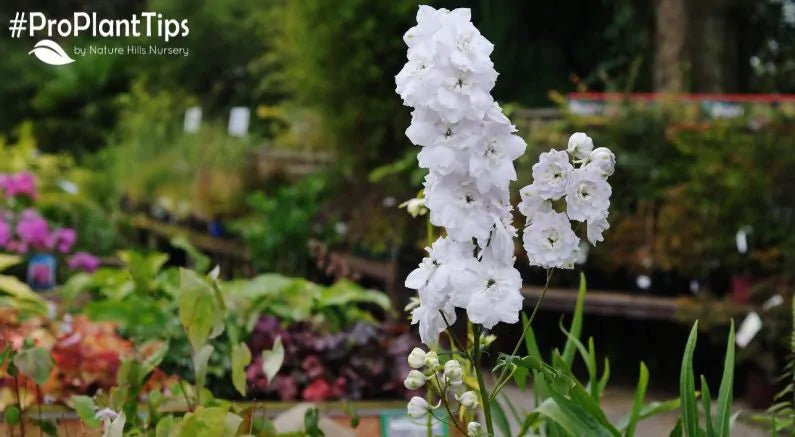Pinching back sounds like it would hurt, doesn't it? Remember getting pinched when you were younger and it either meant you weren’t wearing green at St. Paddy’s Day or meant you had done something to deserve it. Often it involved sore cheeks after your visit with an overly-doting aunt.
After all this, you probably don’t want to think about pinching again! But pinching is actually beneficial for plants!
As counterintuitive as pinching plants sounds, pinching is a pruning technique that encourages branching and bushiness! While it may seem like you are hurting or stunting your plants, making you wait a bit longer for your plants to flower, but the results are nothing short of amazing!
Reasons To Pinch

1. Many annual and perennial plants will be encouraged to grow into more compact domed forms, produce more flowers, and stay smaller.
2. Older plants benefit from pinching to reduce size when they become leggy, and even produce more foliage!
3. You can also pinch off side growth to encourage primary flowering stems to grow and have the plant put all its energy into that single bloom, making it larger and stronger.
4. This pruning style l helps the plant to put out energy on new growth or stop growing and instead produce flowers depending on the timing of the pruning.
5. Many foliage plants do better when they don’t flower, plants such as Coleus for instance, and you really want a nice compact plant with lots and lots of foliage!
6. You can also delay flowering by pinching, either because of some unexpected bad weather approaching, or to time the flowering to align up with other plants in your container garden or garden beds!
7. Nipping off those blooms early also keeps plants from bolting!
8. You can also pinch back plants after they have flowered and want to encourage rebloom or discourage seeds.
Plants That Benefit From Pinching
These perennials and annuals grow fuller, more compact, and flower more profusely when pinched at a young age.
Perennials

Creating tighter mounds and dense, domed clumps with shorter, more even growth, or for taller flowers, you’ll get bigger blooms by eliminating side shoots and smaller flowers forming along the main flowering stem.
- Asters
- Chrysanthemums
- Dahlia
- Sedum
- Delphinium
- Foxglove
- Scabiosa
- Hollyhock
- Geraniums
- Salvia & Russian Sage
- Tall Garden Phlox
Annuals, Herbs & Vegetables
For annual plants, pinch the first year to keep them from bolting, hold off flowering in some types of foliage plants, as well as the many other perks that pruning brings. For Herbs and lettuce for instance, nipping them back creates more leaves and you can toss these pruned bits into your soup, salads, or dried and ground for later use!
For Tomatoes, you want to also nip out the suckers that form in the branching notches (the ‘V’ or ‘axil’ between the branches) and you can pinch back the tops to encourage the energy going into the fruit and existing branches once they reach the desired height.

- Vegetable plants like Peppers, Tomatoes, Lettuce, Broccoli, Greens, and Potatoes
- Bedding Plants - Marigold, Coleus, Petunia, Snapdragons, Zinnia, Cosmos, Phlox, Celosia, Begonia, and Annual Geranium/Scented Geranium
- Tall Plants that usually only have 1 flower - Don’t want 10-foot-tall single Sunflowers? Pinching causes them to stay shorter and produce multiple smaller blooms!
- Many Herbs - Like Basil, Oregano, Mints, Rosemary, Thymes, Tarragon, and Sage
- Brambles can sometimes benefit from tip pruning depending on the variety. It can make them easier to pick by eliminating thorny non-fruiting ends
Pine trees benefit from a form of pinching called ‘Candling’.
How to Pinch Back Plants
To pinch back, you will want to make sure that the plant is at least 2-4 inches tall, or at least 3-4 sets of leaves. While it seems harsh, you will be removing up to a third of the leaves/growth.
You can literally pinch back plants using your fingers and fingernails, or you can use small sterile scissors or garden snips if you are wearing garden gloves or want to save your manicure.

For bushiness and increased flowering, nip back your plant stems by a third down to just above a leaf node along the stem. Soon new shoots will develop on either side of the cut stem. If you can resist waiting for flowers, you can wait until 3-4 new leaf sets have grown on these new shoots and pinch them back again for a denser, bushier plant!
To encourage a single flower to grow larger and more prominently, limiting side shoots and reducing smaller flowers that may form along the stem. This pushes all the plant's energy into the main stem and flower.
Pinch back suckers and side shoots that you don’t want sapping energy from the main plant at any time.
Water your plants well and wait to fertilize until you see those new buds forming.
Once those blooms begin to fade, pinch back the old flowers back to a leaf node and watch as new blooms quickly replace the old! Even if your plants don’t rebloom, deadheading forces the plant to put its energy into its roots for next year instead of seed or fruit.
This also prevents self-seeding and cleans up the entire plant.
Even If They’re Wearing Green, Pinch Them!
So don’t feel bad about pinching and instead have some fun and holler “Off with their heads!” while you are working in the garden! (You may want to whisper it if the neighbors are a bit judgemental.)
It will be a meditative and fulfilling, productive and enjoyable practice while spending time in the garden! It’s also a great chore for small hands and gets the kids involved in the great outdoors!
Happy Planting!


